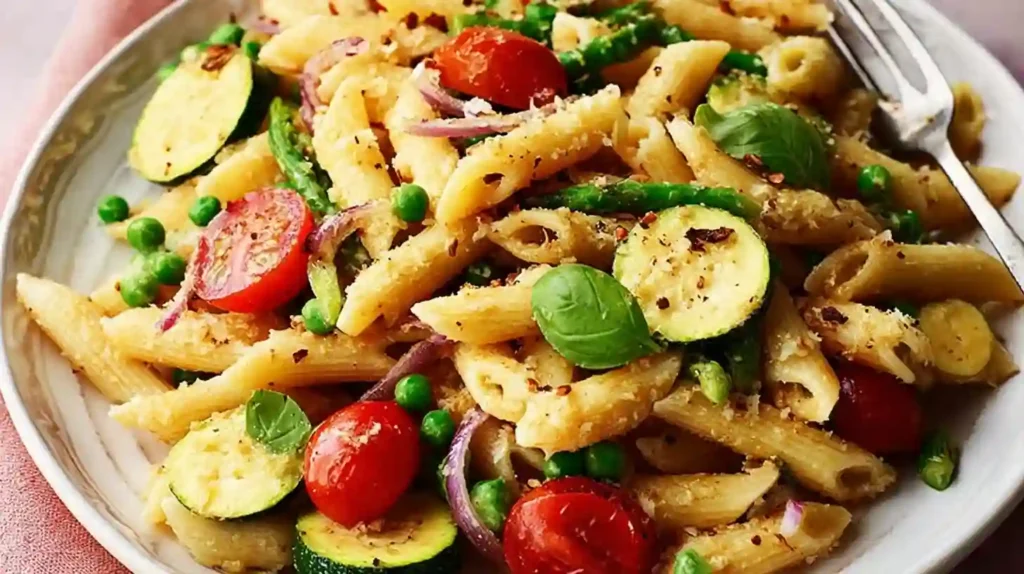Pasta Primavera is the perfect dish to highlight the bright, fresh flavors of spring and summer vegetables. It first gained fame at Le Cirque in New York during the late 1970s, quickly becoming a staple of American-Italian cooking. This isn’t just another recipe. This is your go-to guide to mastering Pasta Primavera at home. You’ll get three different cooking methods to match your style and schedule. Whether you want a quick sauté, a rich roasted flavor, or a one-pot wonder, it’s all right here.
Table of Contents
What Exactly is Pasta Primavera?
Despite its Italian-sounding name, Pasta Primavera is actually an American creation. The word “Primavera” means “spring” in Italian, which reflects the dish’s focus on fresh seasonal vegetables. It was first introduced at Le Cirque, a famous restaurant in New York, in the 1970s. The recipe quickly gained popularity for combining crisp-tender vegetables with pasta in a light, flavorful sauce. While it isn’t traditional Italian fare, it has become a classic in American kitchens thanks to its simplicity, color, and fresh taste.
The Key Ingredients for Perfect Pasta Primavera
To make Pasta Primavera shine, you need fresh, quality ingredients. Here’s a breakdown of what you’ll need, grouped for simplicity:
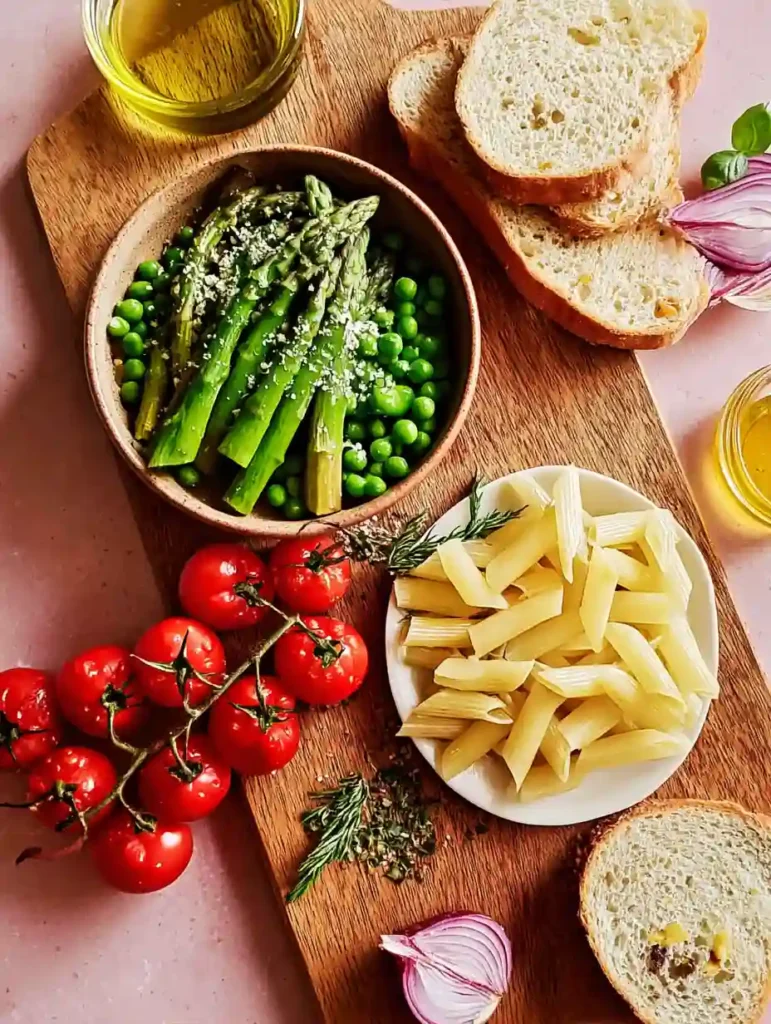
For the Pasta Base
• 10 ounces penne pasta (or use farfalle or fusilli for fun shapes that hold sauce well)
• Sea salt (for salting pasta water generously)
For the Vegetables
• 2 tablespoons extra-virgin olive oil, plus a little more for finishing
• 4 garlic cloves, thinly sliced
• 1 yellow squash, sliced into thin half-moons
• 1 zucchini, also sliced into thin half-moons
• 1 bunch asparagus, trimmed and cut into one-inch pieces
• 1 cup cherry tomatoes, halved for a burst of color and juice
• 1 cup red onion, sliced thin
• 1 cup frozen peas, thawed before adding
• Red pepper flakes, just a pinch for heat
For the Sauce and Finish
• ¾ cup grated pecorino cheese, for a salty, nutty flavor
• 3 tablespoons fresh lemon juice, to brighten the dish
• 1 cup fresh basil leaves, plus extra for garnish
• ¼ cup fresh tarragon (optional, but adds a unique twist)
• Freshly ground black pepper, added to taste
This mix of colorful veggies, fresh herbs, and cheese gives the dish its signature look and flavor. Each component brings its own texture and taste to the final result.
How to Make Pasta Primavera (Choose Your Method!)
There’s no one-size-fits-all way to make Pasta Primavera. That’s why this guide gives you three different options. Whether you need something quick, crave a deeper flavor, or want fewer dishes to wash, you can pick the method that fits your day best.
Method Comparison Table
| Method | Cook Time | Flavor Profile | Cleanup |
| Classic Sautéed | 25 mins | Fresh and vibrant | Moderate |
| Flavorful Roasted | 35 mins | Deep and caramelized | Light |
| Easy One-Pot | 30 mins | Creamy and comforting | Minimal |
Method 1: The Classic Sauté (Fast and Traditional)
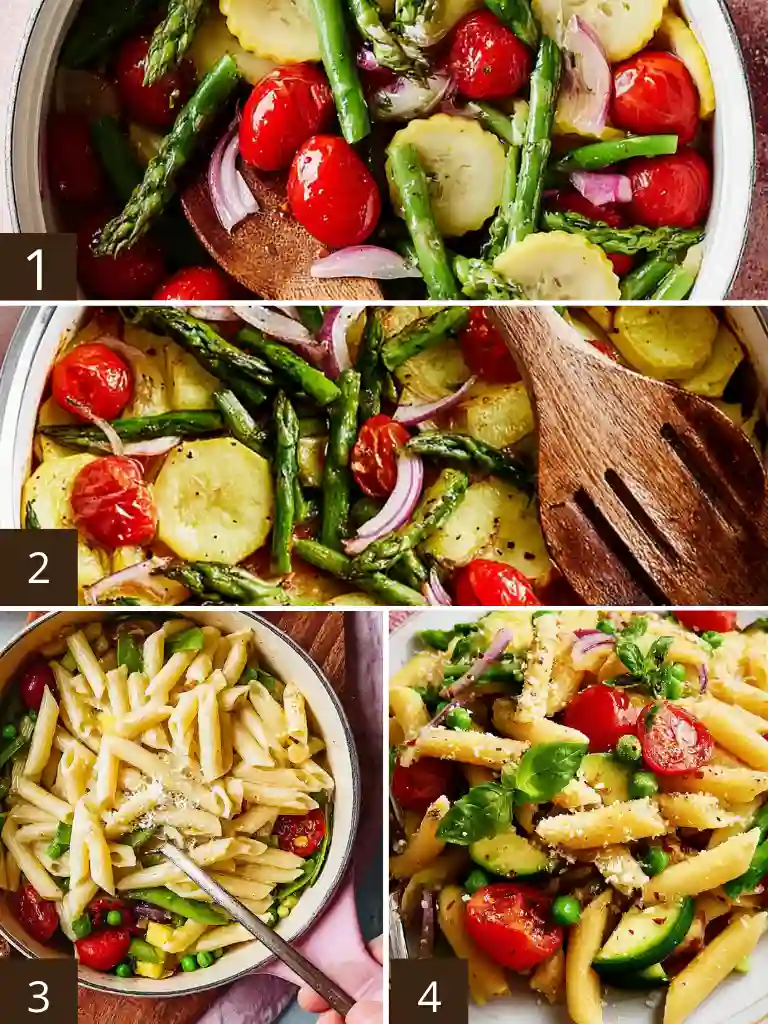
- Boil the pasta
Bring a large pot of salted water to a boil. Add the pasta and cook until al dente. Reserve one cup of pasta water before draining. - Sauté the aromatics
In a large skillet, heat the olive oil over medium heat. Add the sliced garlic and stir for about one minute until fragrant. - Cook the vegetables
Add onion, zucchini, squash, and asparagus. Sauté for five to seven minutes until just tender. Add cherry tomatoes and peas. Stir for two more minutes. - Combine everything
Add the cooked pasta to the skillet. Pour in reserved pasta water a bit at a time while tossing everything together. Stir in lemon juice and grated cheese. - Season and serve
Add salt, pepper, red pepper flakes, and fresh basil. Toss gently and serve warm with more basil or cheese on top.
Method 2: The Flavorful Roast (Deep and Caramelized)
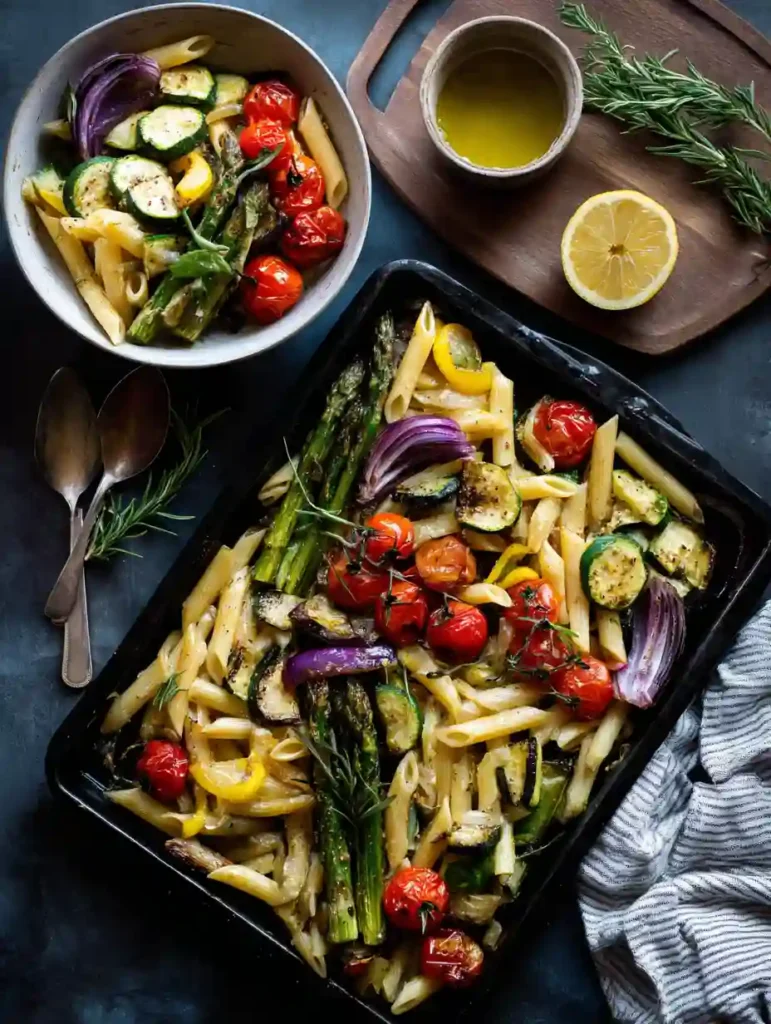
- Preheat the oven
Set the oven to 425°F. Line a large baking sheet with parchment paper. - Prepare the vegetables
In a large bowl, toss squash, zucchini, asparagus, red onion, and cherry tomatoes with olive oil, salt, pepper, and red pepper flakes. - Roast the vegetables
Spread them on the baking sheet in a single layer. Roast for 20 to 25 minutes, flipping halfway through, until browned at the edges. - Boil the pasta
While the vegetables roast, cook the pasta in salted water. Reserve one cup of pasta water, then drain. - Mix it all together
In a large bowl or pan, combine pasta, roasted vegetables, peas, lemon juice, cheese, and a splash of pasta water. Toss until well coated. - Finish and serve
Add chopped basil and tarragon. Taste and adjust seasoning. Serve warm.
Method 3: The Easy One-Pot (Perfect for Weeknights)
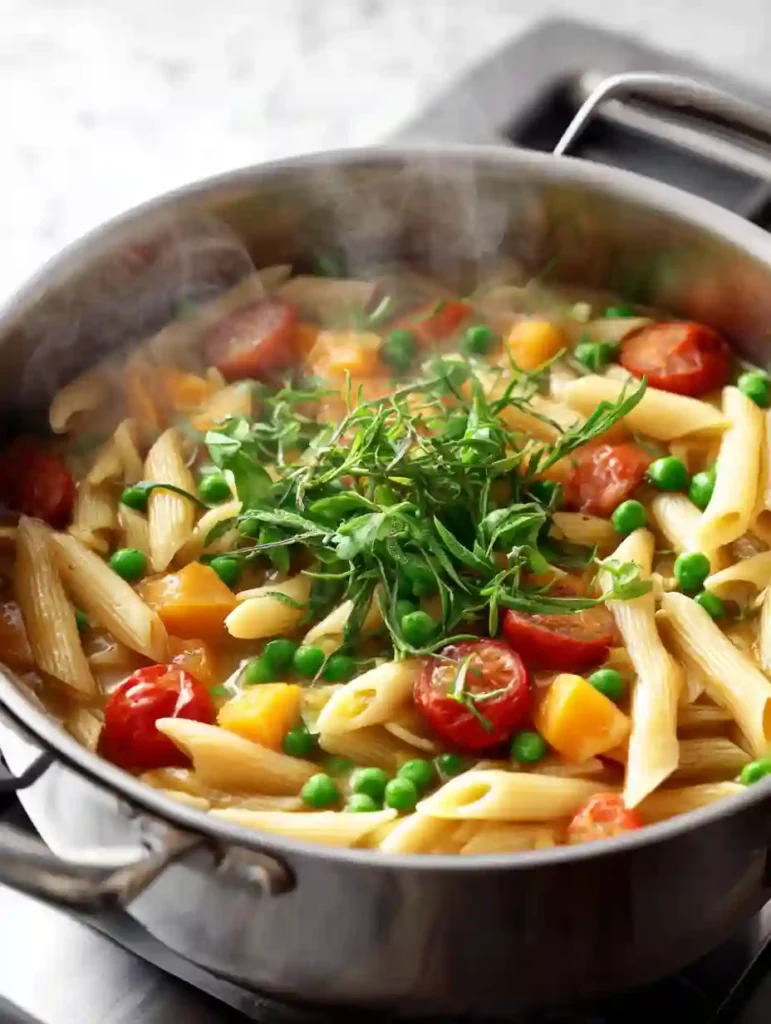
- Start the base
In a large pot, heat olive oil over medium heat. Add garlic and onion. Sauté for two to three minutes. - Add the vegetables
Stir in zucchini, squash, and asparagus. Cook for five minutes, stirring occasionally. - Add the pasta and liquid
Pour in the dry pasta, two and a half cups of water, and a pinch of salt. Stir well. Bring to a simmer. - Cook it all
Cover and cook for about 12 minutes, stirring now and then. Add more water if needed to prevent sticking. - Finish the dish
Once the pasta is cooked and water mostly absorbed, stir in peas, cherry tomatoes, lemon juice, and cheese. - Season and garnish
Top with fresh basil and a little more cheese. Serve warm right from the pot.
Pro-Tips for Restaurant-Quality Results
Use these tips to take your Pasta Primavera from good to great:
Salt your pasta water like the sea
This is your only chance to season the pasta itself. It should taste slightly salty before the pasta goes in.
Save that pasta water
A bit of starchy water helps blend the sauce with the pasta. It adds body without needing extra cream or butter.
Cut vegetables to match the pasta
Smaller cuts cook more evenly and blend better with the pasta. Aim for sizes that match the shape of your pasta.
Cook vegetables in batches
Avoid crowding the pan. Too many veggies at once will steam instead of brown. Browned veggies bring more flavor.
Add fresh herbs at the end
Basil and tarragon lose their punch if cooked too long. Stir them in just before serving to keep their color and aroma.
Taste and adjust
Right before serving, check for salt, acid, and heat. A final splash of lemon or a pinch of red pepper can bring it all together.
Easy Recipe Variations and Customizations
Everyone has their own version of Pasta Primavera. Here are easy ways to tweak the dish to match your taste or dietary needs.
Adding Protein
Want to make it heartier? Stir in cooked chicken or shrimp during the final step. For chicken, use grilled or roasted pieces. For shrimp, sauté peeled and deveined shrimp with garlic in olive oil until pink, then mix them in with the pasta.
How to Make Vegan Pasta Primavera
Skip the cheese and butter. Use extra-virgin olive oil for richness and add a splash of the reserved pasta water for silkiness. For a creamy touch, blend soaked cashews with lemon juice and a little garlic to make a quick cashew cream. Nutritional yeast adds a cheesy flavor without dairy.
How to Make it Gluten-Free
Use a gluten-free pasta that holds its shape well. Brown rice pasta, chickpea pasta, or corn-based fusilli are great choices. Just be careful not to overcook them, as they can get mushy. Follow the same instructions as usual, swapping in your pasta of choice.
What to Serve with Pasta Primavera
Pasta Primavera is light and colorful, making it easy to pair with simple sides that complete the meal.
Buttery garlic bread
Crispy and warm with a soft center, this classic side is perfect for soaking up any extra sauce.
A simple green salad
Toss fresh greens with a lemon vinaigrette. The bright acidity balances the creamy elements of the pasta.
Lemon roasted potatoes
Roasted baby potatoes with olive oil and lemon offer a hearty, citrusy contrast that works beautifully with the vegetable pasta.
Steamed broccoli or green beans
Lightly seasoned and steamed until just tender, these veggies add texture and keep the meal balanced.
Storing and Reheating Leftovers
Pasta Primavera is best enjoyed fresh, but it stores well for later meals if handled properly.
Storage
Let the pasta cool completely before transferring it to an airtight container. Keep it in the refrigerator for up to three days. This helps maintain the texture and prevents the sauce from separating.
Reheating
For best results, reheat leftovers in a skillet over medium-low heat. Add a splash of water or broth to loosen the sauce and bring back its creamy texture. Stir gently until heated through. Avoid the microwave if possible, as it can make the vegetables soggy and the pasta unevenly warm.
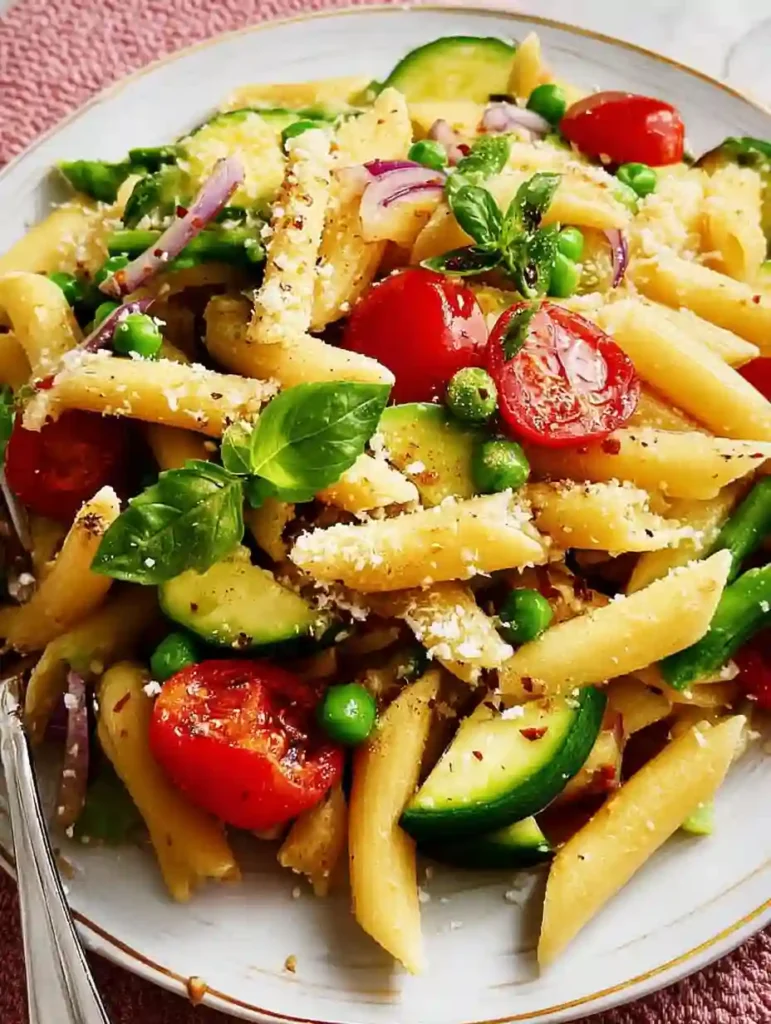
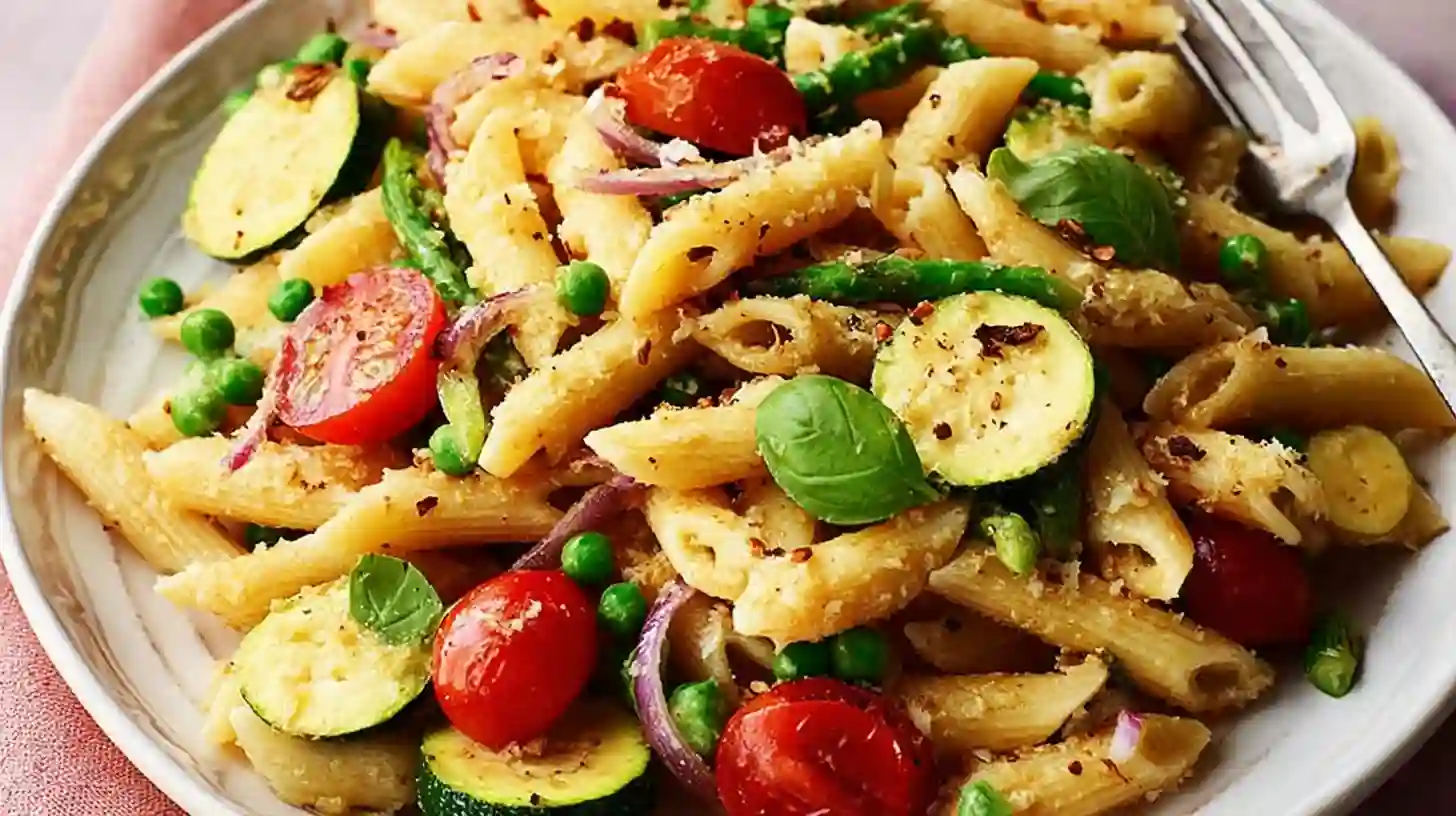
Pasta Primavera
Ingredients
Equipment
Method
- Bring a large pot of salted water to a boil. Add penne and cook until al dente. Reserve 1 cup pasta water and drain.
- In a large skillet, heat olive oil over medium heat. Add sliced garlic and sauté until fragrant, about 1 minute.
- Add onions, zucchini, squash, and asparagus. Cook 5 to 7 minutes until just tender. Stir in cherry tomatoes and peas.
- Add the drained pasta to the skillet. Pour in pasta water a little at a time and stir in lemon juice and pecorino cheese.
- Season with salt, pepper, and red pepper flakes. Add fresh basil and tarragon at the end. Toss gently and serve warm.
Notes
Calories: 411
Total Fat: 27g
Carbohydrates: 33g
Protein: 12g
Saturated Fat: 7g
Cholesterol: 20mg
Sodium: 480mg
Fiber: 5g
Sugars: 6g
Conclusion
Pasta Primavera brings color, flavor, and freshness to your table with every bite. Whether you choose to sauté, roast, or go for the one-pot version, each method delivers satisfying results with its own twist. This guide is built to help you master the dish your way.
If you tried this recipe, leave a comment and a star rating. Share your experience on Pinterest or Facebook so others can enjoy it too. What vegetables or variations did you use? We’d love to hear how you made it your own.
Frequently Asked Questions
What is pasta primavera made of?
Pasta Primavera is made with cooked pasta and a mix of fresh vegetables like zucchini, squash, cherry tomatoes, asparagus, and peas. It often includes garlic, olive oil, lemon juice, and grated cheese for flavor.
Is Primavera the same as Alfredo?
No, they are different. Alfredo is a creamy white sauce made mainly with butter, cream, and cheese. Primavera focuses on fresh vegetables and may or may not include a light sauce, often lemon or cheese-based.
What does primavera mean for pasta?
Primavera means “spring” in Italian. In cooking, it refers to pasta dishes that highlight seasonal vegetables, especially those found in spring and early summer.
How to thicken primavera sauce?
Use a bit of the starchy pasta water to thicken the sauce naturally. Let the mixture simmer until it coats the pasta. Grated cheese also helps the sauce stick without becoming too heavy.
How to make the perfect pasta primavera?
Use fresh, in-season vegetables and don’t overcook them. Salt your pasta water, save some of it to mix with your sauce, and add fresh herbs right before serving for a burst of flavor.
How to flavour white sauce?
For more depth, add garlic, lemon juice, or a pinch of red pepper flakes. Stir in fresh herbs like basil or tarragon at the end. Grated cheese like pecorino or Parmesan gives a savory boost.
For more creative cooking & baking inspiration ideas, explore the Pinterest or connect with us on Facebook.

